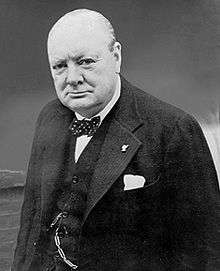John Strange Spencer-Churchill
Major John Strange "Jack" Spencer-Churchill, DSO, TD (4 February 1880 – 23 February 1947) was the younger son of Lord Randolph Churchill and his wife Jennie, and the brother of former Prime Minister of United Kingdom Sir Winston Churchill.
Early life and marriage

He was born at Phoenix Park, Dublin, Ireland, where Lord Randolph was secretary to his grandfather, the 7th Duke of Marlborough, then Viceroy of Ireland. John was educated at Harrow School in England. Jennie's sisters believed that John's actual biological father was Evelyn Boscawen.[1]
He married, in Oxford on 8 August 1908, Lady Gwendoline Theresa Mary Bertie (20 November 1885 – 7 July 1941), the daughter of Montagu Bertie, 7th Earl of Abingdon and Gwendoline Mary Dormer. Lady Gwendoline was a Roman Catholic, as her father had converted before her birth.
Military career

He was commissioned into the Queen's Own Oxfordshire Hussars in 1898. He served in the South African Light Horse alongside his war correspondent brother in the Second Boer War in 1899–1900. He was Mentioned in Dispatches, and was shot through the leg in February 1900, during the Battle of the Tugela Heights, part of the campaign for the relief of Ladysmith.[2][3]
He fought in World War I, where he was again Mentioned in Dispatches. He served on the staff of Field Marshal Lord French, General Sir Ian Hamilton (serving as Naval Liaison Officer for the Mediterranean Expeditionary Force) and Field Marshal Lord Birdwood (serving as Camp Commandant, 1st Anzac Corps, and then as Assistant Military Secretary at the headquarters of the Fifth Army).
He reached the rank of Major and was awarded the French decorations of the Croix de guerre and the Légion d'honneur and the British Distinguished Service Order in 1918. After the war, he became a businessman in the City of London.
During World War II, the widowed John lost his house during the Blitz and he lived in 10 Downing Street.[4] He lived in either No 10 (where he used the bedrooms on the top floor formerly used by Churchill and his wife) or the No 10 Annex.[5]
Death
He died on 23 February 1947, aged 67, of heart disease and is buried near his parents and brother (who outlived him for 18 years, despite being older in age) at St Martin's Church, Bladon, near Woodstock, Oxfordshire.[4]
Children
John and his wife had three children:
- John George Spencer-Churchill (31 May 1909 –1992)
- Henry Winston Peregrine Spencer-Churchill (25 May 1913 – 19 March 2002)
- Anne Clarissa Churchill, Countess of Avon (born 28 June 1920), the widow of the former prime minister Anthony Eden
References
- ↑ Sebba, Anne. American Jennie: The Remarkable Life of Lady Randolph Churchill, Norton, 2008
- ↑ "The War - Natal". The Times (36067). London. 16 February 1900. p. 5.
- ↑ Churchill, W. S. London to Ladysmith via Pretoria London: Longmans, Green & Co. 1900, pp. 168–69
- 1 2 Mary Soames in her edition of the Churchill letters.
- ↑ Holmes, Richard. Churchill’s Bunker 2009, Profile Books; ISBN 978-1-84668-225-4, pp. 82, 107
